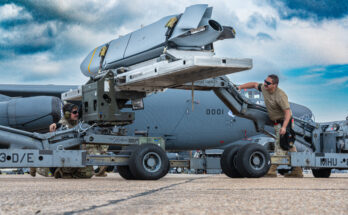by Shaun McDougall, Military Markets Analyst, Forecast International.
The U.S. House of Representatives recently passed its version of the FY19 defense authorization bill by a vote of 351-66. The bill supports a Pentagon base budget of $639.1 billion, which complies with the two-year budget deal agreed upon earlier this year that amended national security spending caps in FY18 and FY19. This base spending includes $617.1 billion for the Pentagon, $21.8 billion for nuclear programs in the Department of Energy, and $214 million for other defense-related activities. The bill recommends $69 billion for Overseas Contingency Operations (OCO), matching the request, for a total of $708.1 billion in discretionary defense spending in FY19.
The legislation includes an increase of $338.1 million for Stryker A1 vehicles and $85 million for five additional Army National Guard UH-60M Black Hawks, and additional funding to maintain the maximum production rate of “critical munitions,” such as Small Diameter Bombs, Joint Direct Attack Munitions, HELLFIRE missiles, Advanced Precision Kill Weapon Systems, long-range anti-ship missiles, Tomahawk missiles, Advanced Medium-Range Air-to-Air Missiles, and torpedoes. The bill recommends adding $150 million to accelerate efforts to field a conventional prompt global strike capability before FY22, and encourages the rapid development of interim short-range air defense and indirect fire protection capabilities.
The House Armed Services Committee takes issue with the Air Force’s decision to cancel its E-8 Joint Surveillance Target Attack Radar System (JSTARS) recapitalization program. The House markup would direct the Air Force to continue the recapitalization effort, adding $623 million for this purpose. The bill also adds $60 million for Army MQ-1C Gray Eagle capabilities and $105 million for the EQ-4, a variant of the Global Hawk equipped with the Battlefield Airborne Communications Node (BACN). House lawmakers also continue to push for the Navy to develop an unmanned anti-access penetrating long-range strike capability, in addition to the current work on the MQ-25 unmanned tanker. At the same time, the HASC has expressed concerns about the Marine Air Ground Task Force Unmanned Expeditionary (MUX) project, and cuts $15 million in development funding for the unmanned aerial vehicle (UAV) effort.
Additionally, the Navy receives a $1 billion increase in advance procurement funding for the Virginia class submarine to increase future production, $950 million for two Littoral Combat Ships, and $150 million in advance procurement funding in support of the LPD Flight II, formerly known as the LX(R).
The legislation supports the Nuclear Posture Review’s recommendation to develop a lower-yield ballistic missile warhead to strengthen deterrence, and adds funding to accelerate modernization of ground-based ballistic missiles and the Long-Range Standoff cruise missile. Another $140 million is added to the Missile Defense Agency budget for directed energy, space sensor, and hypersonic missile defense capabilities. The bill adds funding to accelerate integration of the Patriot and Terminal High Altitude Area Defense (THAAD) systems, and $30 million for the Army to conduct an operational demonstration of Iron Dome missile defense hardware. The bill would also direct the MDA to establish a boost phase intercept program using kinetic interceptors.
The also bill includes a number of provisions impacting U.S. space programs. The legislation would direct the Department of Defense to establish a separate process for space acquisition, establish a new numbered Air Force responsible for carrying out space warfighting, establish a sub-unified command for space under the Strategic Command, and increase the size of the space cadre.
 As editor of International Military Markets, North America, Shaun has cultivated a deep understanding of the vast defense markets in the United States and Canada. Further, Shaun played an integral role in the development of Forecast International’s U.S. Defense Budget Forecast product, which offers an unprecedented level of insight into the Pentagon’s acquisition budget.
As editor of International Military Markets, North America, Shaun has cultivated a deep understanding of the vast defense markets in the United States and Canada. Further, Shaun played an integral role in the development of Forecast International’s U.S. Defense Budget Forecast product, which offers an unprecedented level of insight into the Pentagon’s acquisition budget.
For 50 years, Forecast International intelligence reports have been the aerospace and defense industry standard for accurate research, analysis, and projections. Our experienced analysts compile, evaluate, and present accurate data for decision makers. FI's market research reports offer concise analysis of individual programs and identify market opportunities. Each report includes a program overview, detailed statistics, recent developments and a competitive analysis, culminating in production forecasts spanning 10 or 15 years. Let our market intelligence reports be a key part of reducing uncertainties and mastering your specific market and its growth potential. Find out more at www.forecastinternational.com




